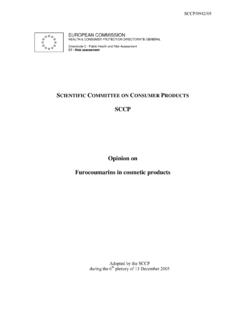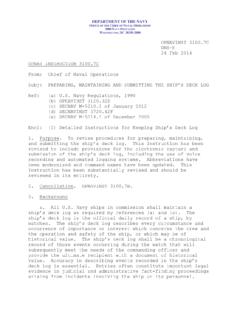Transcription of TERMS OF REFERENCE FOR GUYANA HINTERLAND STAND …
1 I TERMS OF REFERENCE FOR GUYANA HINTERLAND STAND -ALONE SOLAR PV INSTALLATIONS IMPLEMENTED UNDER THE USAID IHFI GUYANA CONTRACT No. EPP-I-00-03-00008-00, TASK ORDER 07. Prepared by: Tetra Tech 4601 N. Fairfax Drive Suite 601 Arlington, VA 22203 USA Tel: +1-703-387-2134 Fax: +1-703-387-2160 ii Table of Contents 1. Background .. 1 Solar radiation 2 2. Solar System Design .. 4 Design 1 PV System for One Vaccine Refrigerator and Eight Light Bulbs .. 4 HOMER Input Parameters .. 4 HOMER Simulation Results .. 5 Design 1 - HOMER Input and Output Summary .. 5 Design 2 Solar PV for Eight Light Bulbs Load .. 9 HOMER Inputs .. 9 HOMER Simulation Results .. 9 Design 2 - HOMER Input and Output Summary .. 10 Design 1 Single Line Diagram for Solar Vaccine Refrigerator and Light System .. 14 Design 2 - Single Line Diagram for Solar Light System .. 15 3. Solar System Bid Specifications.
2 16 4. Bidder s Data Sheets .. 22 A. IHFI GUYANA PV Installation: Bidder s Response .. 22 B. System Cost Data Sheet .. 23 C. Bill of Materials Data Sheet .. 23 Appendix A; Site drawings- Proposed sighting of solar system .. 24 Appendix B: Health Facility Floor Plan Solar Systems Wiring Diagram .. 28 Appendix C: Load and energy requirement for health clinics .. 34 1 Solar Electrification for HINTERLAND Health Facilities in GUYANA TERMS of REFERENCE for Solar Systems Procurement 1. Background The high cost and intermittent supply of electric power present a major challenge in the GUYANA health sector. In rural areas, this is further exacerbated due to lack of grid electricity, regular supply of diesel fuel, availability of local capacity to ensure proper maintenance of energy systems and, in most cases, the inaccessibility of health facility sites hinders delivery of the health services.
3 The Improving Health Facility Infrastructure (IHFI) project, funded by USAID, works to improve energy access, reliability, and cost reduction in health facilities in countries around the world. In GUYANA , IHFI is focusing on solar PV electrification of rural health centers and clinics, but has also identified a potential and a need for energy efficiency improvements. In this context the IHFI GUYANA energy team conducted sites assessments of twelve HINTERLAND health centers/outposts to capture information on the existing health and energy infrastructure for each health facility in order to design and implement energy solutions for better delivery of health services. Overall twelve health facilities were selected for site assessments six in Region 1, one in Region 7, three in Region 8 and two health facilities in Region 9. Of the twelve sites assessments, nine health facilities would require solar energy infrastructure augmentation.
4 Table1: HINTERLAND health facilities to receive solar PV installations Region Health Facility Region 1 Matthews Ridge District Hospital Baramita Health Center Arakaka Health Center Kwebana Health Center Region 7 Itabali Health Post Region 8 Tumatumari Health Center Paramahktoi Health Post Region 9 Aishelton Cottage Hospital Karasabai Health Center 2 The key findings from the site assessments are: a. Most of the systems are either single-panel or two-panel systems, so there is no critical mass or redundancy available. b. Battery storage was not properly designed one battery per system is insufficient when several days of overcast skies are typical during the rainy season. c. Electrical circuitry was not properly designed no circuit breakers or protection devices were installed, so the solar PV system components have failed due to various abnormal electrical conditions such as overvoltage, high current from short circuits, and completely drained batteries d.
5 Batteries were not maintained, so they cannot hold the charge. e. Solar panels are improperly installed (inside rooms, overlapping on roofs), so do not reach their potential performance. f. Poor electrical installations result in burned out sockets, so solar PV cannot be fully used. The objective of the IHFI GUYANA solar project is to develop a model design, installation and maintenance program for solar systems primarily to achieve the following key goals: Develop standard design criterion for solar PV systems. Design large capacity systems to be able to withstand weather anomalies. Install systems with adequate controls and protections. Develop a battery maintenance program, including hands-on training, to provide maintenance training to local technicians. Solar radiation availability GUYANA is located close to the equator; approximately bounded between Latitudes 2O N to 9O N.
6 Given the latitude, the average daily solar radiation over the targeted solar installations sites is likely to be high. However, the following tables show that the available irradiation is not as high as expected. This is due to the fact that these areas are typical of dense rain forests and experience frequent cloud obstruction. This is evidenced from the fact that the diffuse radiation is more than 40% of the total global horizontal radiation for each site. According to local sources during our sites assessment, the overcast sky conditions persist for several days, especially during the rainy seasons. Note that in GUYANA the rainy season extends for over six months. It is important that the battery capacity and solar panels for each system are sized appropriately to withstand weather anomalies. 3 Table 2A: Global Horizontal Radiation (kWh/m2/day) Region Health Facility Loacation Jan Feb Mar Apr May Jun Jul Aug Sept Oct Nov Dec Average Region 1 Matthews Ridge, Baramita, Arakaka & Kwebana Region 7 Itabali Region 8 Tumatumari Paramahktoi Region 9 Aishelton Karasabai Source: Table 2B.
7 Diffuse Horizontal Radiation (kWh/m2/day) Region Health Facility Loacation Jan Feb Mar Apr May Jun Jul Aug Sept Oct Nov Dec Average Region 1 Matthews Ridge, Baramita, Arakaka & Kwebana 2 Region 7 Itabali Region 8 Tumatumari Paramahktoi Region 9 Aishelton 2 Karasabai Source: Table 2C: Diffuse Radiation as % of Global Horizontal Radiation Region Health Facility Loacation Diffuse Radiation % of Global Horizontal radiation Region 1 Matthews Ridge, Baramita, Arakaka & Kwebana 41% Region 7 Itabali 44% Region 8 Tumatumari 44% Paramahktoi 40% 4 Region 9 Aishelton 41% 2. Solar System Design Based on site assessment of the health clinics, the electrical loads to be connected to the solar PV systems are proposed for two cases: (a) one vaccine refrigerator and eight 20 W CFL light bulbs and (b) eight 20 W CFL light bulbs.
8 Shown in the following table are the loads and energy requirements for one health center that received an on-site assessment. Electrical loads and energy requirements are provided for all nine facilities in Appendix C. Table 3: Electrical Loads Served by Solar PV System Based on the above load and energy requirements, two standard designs for the solar PV systems are proposed: Design 1 PV System for One Vaccine Refrigerator and Eight Light Bulbs HOMER Input Parameters Daily Energy requirement: 1702 Wh/day Battery Input: U S Battery, 6V, 305 Amp-hr. System Voltage: 24 Volts Baramita Health Center (Region 1)Front BuildingQtyCFL BulbTotalTotal Watt-hoursLighting Load (AC Load)DurationHrsWattsWattsExterior light7 to 5 quarter612020120 Outpatient Room512020100 Patient ward/Malarial room7 to 5 room612020120 Store room/Vacc. Ref room41202080 Medicine Storage512020100 Corridor Light7 to 5 Plug Loads (15% of 1480 Whr)222 Vaccine Refrigerator Load (DC Load)VR WattsOne Vaccine Refrigerator616060360 Total2201702 Rear BuildingQtyCFL BulbTotalTotal Watt-hoursAC LoadDurationHrsWattsWattsExterior light7 to 5 ward7 to 5 Lab512020100 Other indoor areas6520100600 Other Plug Loads (15% of 1100 Whr)165 Total1601265 Operating HoursOperating Hours5 Solar radiation grid: Latitude 5o N and 59o W (Solar resource obtained from inbuilt database) Loss factors a.
9 Incident Angle Modifier Loss: 3% b. Temperature loss: 10% c. Charge controller loss 5% d. Array mismatch loss: e. Wire loss: 2% f. Dust irradiance loss: g. Inverter loss: 5% h. Battery loss: 20% Total loss factor: (1-a)*(1-b)*(1-c)*(1-d)*(1-e)*(1-f)*(1-g ) *(1-h)= HOMER Simulation Results Design 1 - HOMER Input and Output Summary SYSTEM DESIGN CTITEION: PV array and battery bank size to maintain Battery Depth of Discharge (DOD) of 50% and no more than twice in a month the DOD reaches 60%: 6 HOMER Output: A. PV array size: kW B. Battery Bank: 305 Amp-hr, 24 Voltage system Sensitivity case Maximum Annual Capacity Shortage: 5 % System architecture PV Array kW Battery 4 USB US-305 Inverter kW Energy Component Production Fraction (kWh/yr) PV array 1,244 100% Total 1,244 100% Load Consumption Fraction (kWh/yr) AC primary load 621 100% Total 621 100% Quantity Value Units Excess electricity 502 kWh/yr Unmet load kWh/yr Capacity shortage kWh/yr Renewable fraction 7 PV Quantity Value Units Rated capacity kW Mean output kW Mean output kWh/d Capacity factor % Total production 1,244 kWh/yr Quantity Value Units Minimum output kW Maximum output kW PV penetration 200 % Hours of operation 4,380 hr/yr Levelized cost $/kWh Battery Quantity Value String size 4 Strings in parallel 1 Batteries 4 Bus voltage (V)
10 24 Quantity Value Units Nominal capacity kWh Usable nominal capacity kWh Autonomy hr Lifetime throughput 3,856 kWh 8 Battery wear cost $/kWh Average energy cost $/kWh Quantity Value Units Energy in 446 kWh/yr Energy out 358 kWh/yr Storage depletion kWh/yr Losses kWh/yr Annual throughput 400 kWh/yr Expected life yr Converter Quantity Inverter Rectifier Units Capacity kW Mean output kW Minimum output kW 9 Maximum output kW Capacity factor % Quantity Inverter Rectifier Units Hours of operation 8,760 0 hrs/yr Energy in 654 0 kWh/yr Energy out 621 0 kWh/yr Losses 33 0 kWh/yr Design 2 Solar PV for Eight Light Bulbs Load HOMER Inputs Daily Energy requirement: 1265 Wh/day Battery Input: Trojan 105 Battery, 6V, 225 Amp-hr. System Voltage: 24 Volts Solar radiation grid: Latitude 5o N and 59o W (Solar resource obtained from inbuilt database) Loss factors a.






